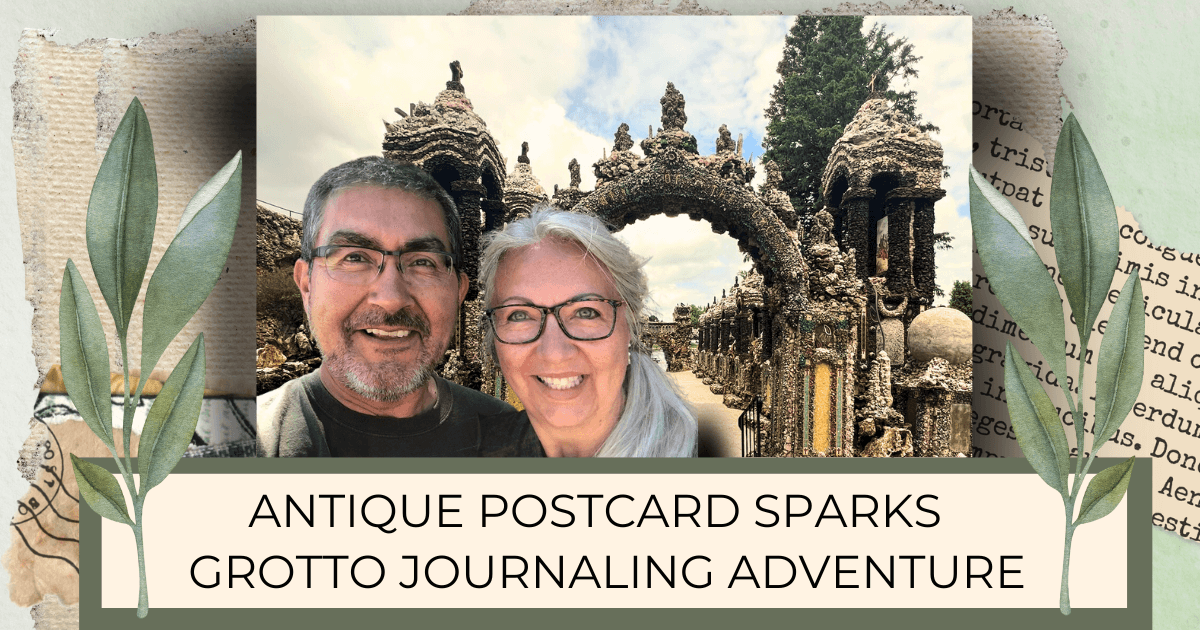
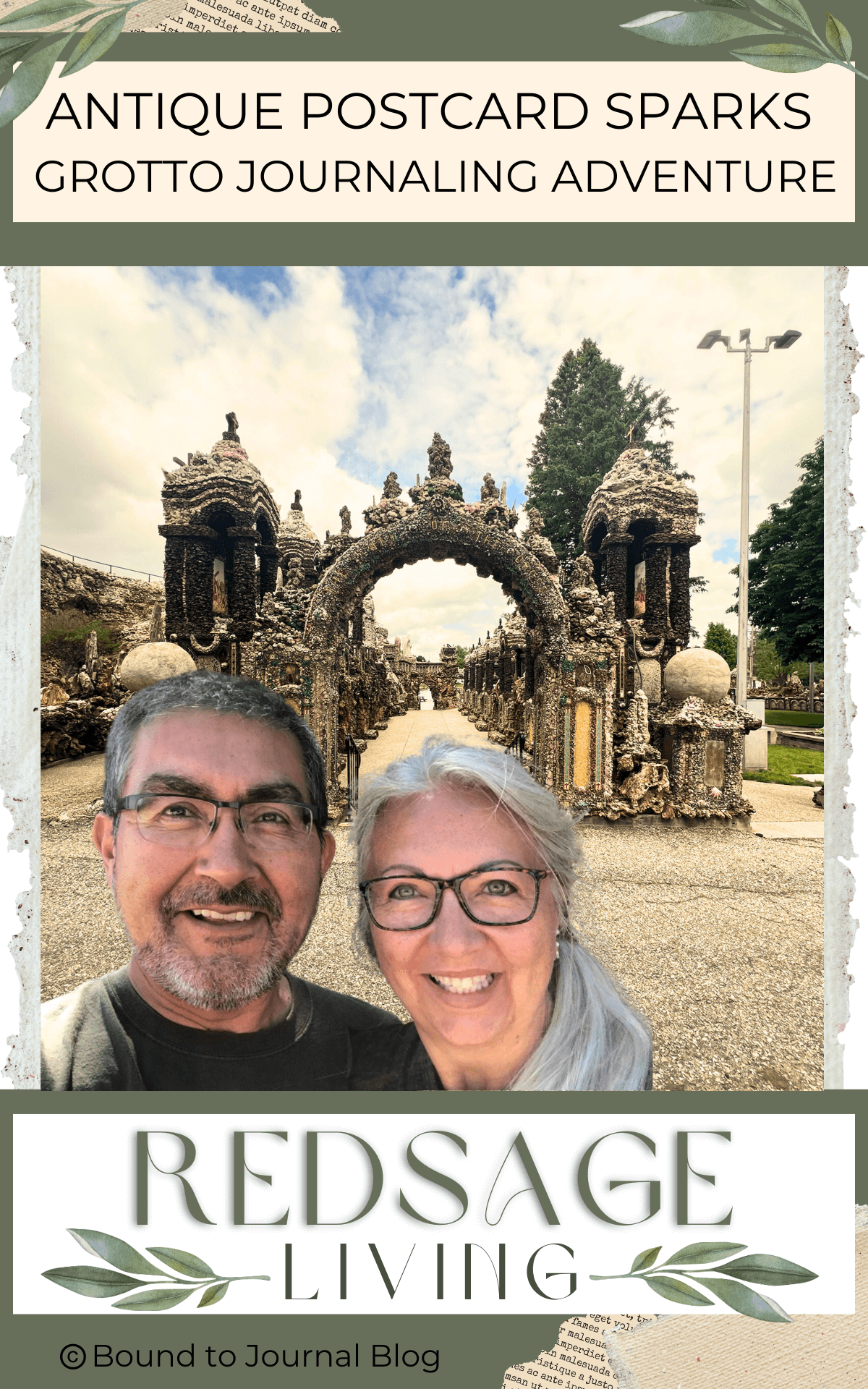 In an unexpected twist of fate, a postcard folder discovered in anantique shop in Minnesota 25+ years earlier sparked a journaling adventure that would lead us through the heart of America's most historic and spiritual grottoes.
In an unexpected twist of fate, a postcard folder discovered in anantique shop in Minnesota 25+ years earlier sparked a journaling adventure that would lead us through the heart of America's most historic and spiritual grottoes. The hand-colored postcard images stretched out in front of us of a beautiful, almost fairytale-like structure were taken at the Grotto of Redemption in West Bend, Iowa. Little did we know those images would lead us on a journaling adventure!
The word “grotto,” like the postcard folder itself, continued to surface over the years, keeping the idea fresh and the intrigue heightened. One afternoon, after another particularly aggressive nudge, I hit the internet to do a little research. To my surprise, the Grotto of Redemption was not only still in existence and maintained, but it was also within a few hours of our home! And, it's believed to be the largest grotto in the world and welcomes visitors!
That antique postcard sparked another exciting journaling adventure.
*Make sure to read to the end to access BONUS jouraling tips and resources.

So, what’s a grotto?
Religious grottoes are sacred spaces often used as shrines to pray to saints or quiet places used as sanctuaries to reflect and contemplate.
Around the United States, many grottos are smaller garden shrines with a single statue or image of a saint. They often have a simple, rustic, and nature-inspired beauty. The designs adorning the backdrop or framing the shrine are frequently created using variations in rocks and shells, laid out in decorative symbolic or iconographic designs to accent the saint.
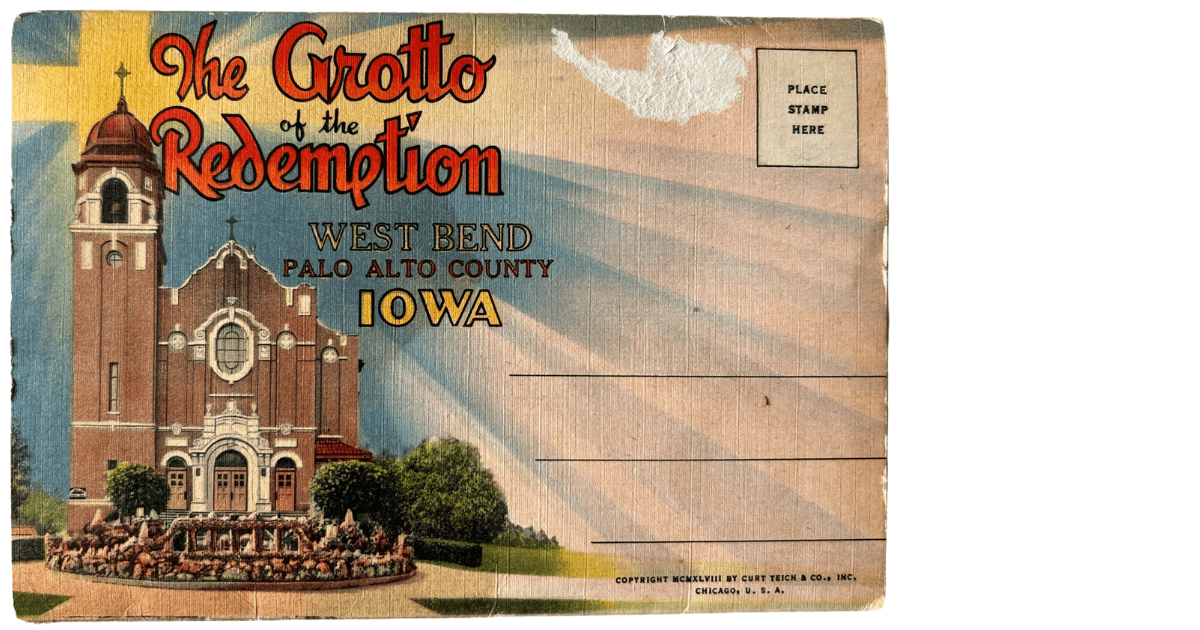
Who made the grottoes and when?
Most of the historic religious grottoes in the Midwest were built in the early 20th century by German-American Catholic priests, friars, and parishioners.
Each grotto has a unique history behind its creation. For example, Fr. Paul Doberstein (1872-1954) built the Grotto of Redemption after a bout of pneumonia to thank Mary for answering his prayers and curing him.
The base structures are designed and stabilized using rock, mortar, and other available support materials as needed. Specific-sized rocks and shells are chosen for the designs and then intricately hand-mortared into place with careful precision to emphasize the pattern and symbolism of the design.
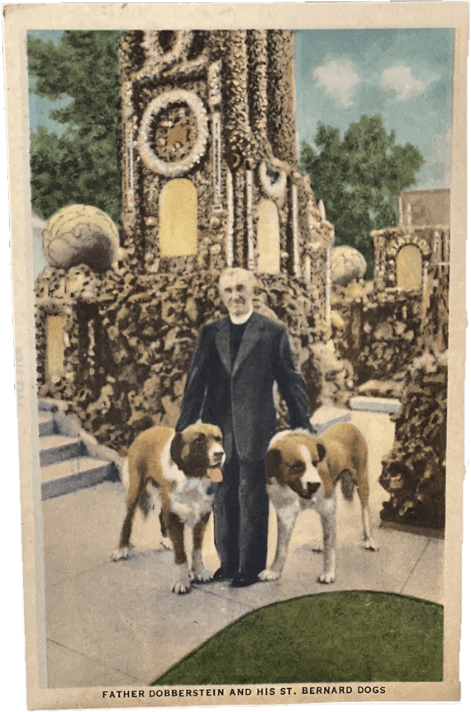
Where are the historic grottoes today?
The Grotto of Redemption, in West Bend, Iowa, is a shrine that includes nine grottoes depicting scenes from Jesus's life.
Paths, gardens, sanctuaries, stairs to a second level, statues,and images. This amazing collection of petrified wood, shells, and precious stones valued at over $2,500,000 adorn the surfaces! Visitors are welcomed 24 hours a day, 7 days a week. The grounds include a museum, gift shop, pond, and resident swans.
We were so impressed with the Grotto of Redemption that we started to dig into other historic grottoes. It turns out that South Dakota has two still in existance: Saint Martin’s and Saint Peter’s.

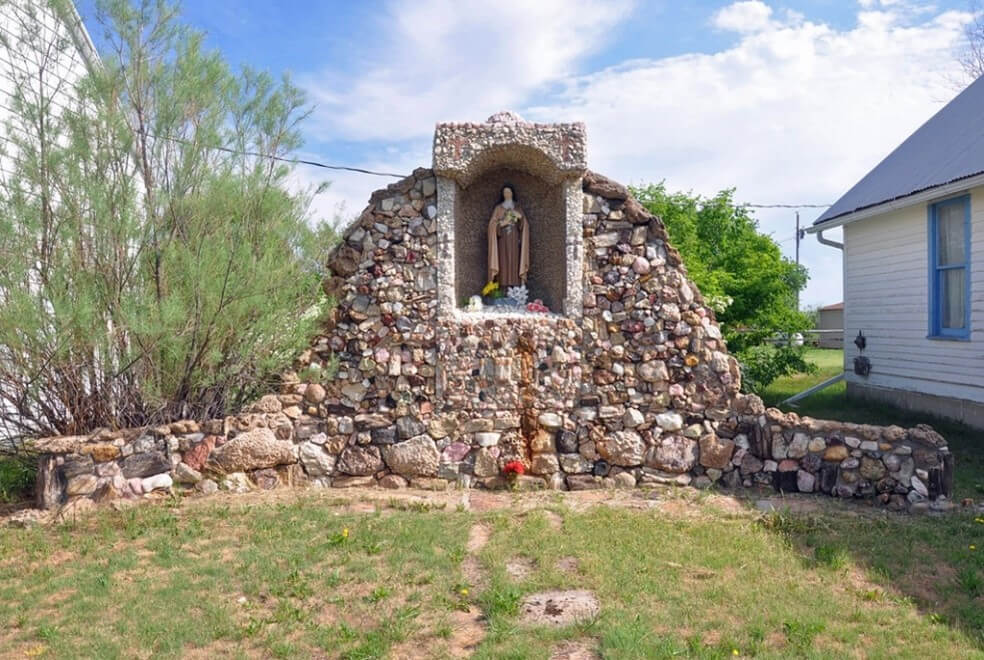
The Grotto at St Martin's, Oelrichs, SD, (1932-34) is a smaller wall-styled grotto that gently curves around the featured statue of Mary. Saint Peter’s (1926-33). It stands next to the Catholic Church built in 1885. The church is a single-story building with a stone foundation. It's recognized on the National Register of Historic Places. Their grotto was built by Father Gerhard Stakemeir and a parishioner between 1932-34.
The Grotto of St. Martin's is a free-standing, semi-circular wall flanking a niche holding a statue of Mary, Jesus's mother. The wall is made with unique, carefully chosen rocks that are visually balanced to create a focal frame around Mary.
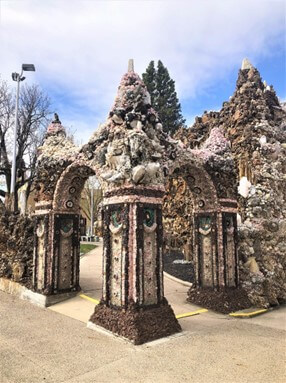
Our research brought up very few additional existing grottoes. The few additional examples were more contemporary is style, and varied in age, historical significance, and design.
- The Grotto of Our Lady of Lourdes, University of Notre Dame
- The National Sanctuary of our Sorrowful Mother, Portland, Oregon
- Ave Maria Grotto in Cullman, Alabama. This intricate miniature landscaped hillside includes 125 stone and cement replica structures! Brother Joseph Zoetl, a Benedictine monk, created his first replica in 1912 and the last in 1958. The story and images had us quickly adding this stop to our travel ideas journal for Alabama.
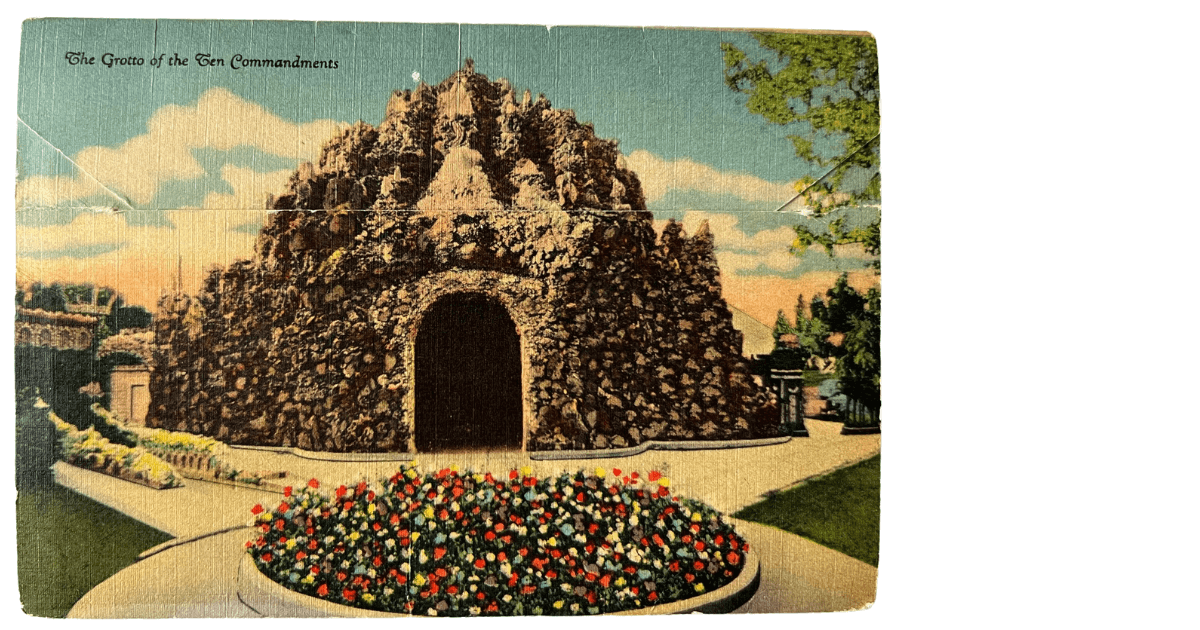
Grotto's Inspiration for Journaling
The journaling options for a trip like this could go in so many directions. Think about what you like and what works for you.
- If you keep a road trip journal, this would definitely be on the list. Record location, reminders for next trip, who traveled with you, and if there's a particular season that's best for this trip.
- If you love studying rocks, the Grotto of Redemption has a rare, priceless collection. You could turn it into a scavenger hunt and record all the precious stones you encounter and their place of origin.
- If you like the historical aspects of the region or the biblical stories, document the dates, names, and details of this historic gem. Make notes of where the stones came from and how the story of the grotto creation spread.
- Take your drawing journal, recreate the images to study the designs, and use them in one of your next collaged pieces.
- Think photo ops! The Grotto of Redemption is said to be as beautiful at night as during the day. Its lighting emphasizes the significant pieces and features in a way you won't see during the day. Pack a lunch or check out the local cafe and schedule a day to capture scenes in a different light, then document the settings you use as the lighting changes. Copy a few images and tip them into your journal to support your descriptions of the day.
- If you love symbolism and iconography, you're in the right place! Draw them, take photos, record clues, and do some research to see all the hints to messages others might miss. The intriquate mosaic designs both around the grottoes and inside the church are imported from Italy. They look like paintings and are edged in gold!
The journey doesn’t end at the grottos. The roads beckon with promises of new adventures, new discoveries, and countless more memories to jot down in my journal. Let the essence of a road trip remind you to seek out journal opportunities and cherish the journey as much as the destination. Remember that the road less traveled sometimes leads to the most unforgettable discoveries, whether it's on a road trip or a deep dive into your journal.
Enjoy the journey.
For more inspirational adventures and journaling, we'd recommend these posts:
*BONUS discover more journaling tips and resources on these PDFs we've created for you! Access resources here






















0 Comments